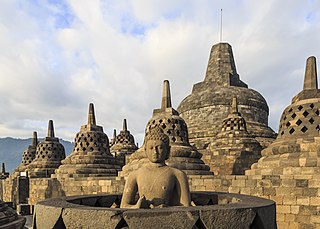 W
WSacral architecture is a religious architectural practice concerned with the design and construction of places of worship or sacred or intentional space, such as churches, mosques, stupas, synagogues, and temples. Many cultures devoted considerable resources to their sacred architecture and places of worship. Religious and sacred spaces are amongst the most impressive and permanent monolithic buildings created by humanity. Conversely, sacred architecture as a locale for meta-intimacy may also be non-monolithic, ephemeral and intensely private, personal and non-public.
 W
WBengal temple architecture is about temple styles developed and used in Bengal, particularly the chala, ratna and dalan temples.
 W
WBuddhist religious architecture developed in the Indian subcontinent. Three types of structures are associated with the religious architecture of early Buddhism: monasteries (viharas), places to venerate relics (stupas), and shrines or prayer halls, which later came to be called temples in some places.
 W
WChurch architecture refers to the architecture of buildings of churches, convents, seminaries etc. It has evolved over the two thousand years of the Christian religion, partly by innovation and partly by borrowing other architectural styles as well as responding to changing beliefs, practices and local traditions. From the birth of Christianity to the present, the most significant objects of transformation for Christian architecture and design were the great churches of Byzantium, the Romanesque abbey churches, Gothic cathedrals and Renaissance basilicas with its emphasis on harmony. These large, often ornate and architecturally prestigious buildings were dominant features of the towns and countryside in which they stood. However, far more numerous were the parish churches in Christendom, the focus of Christian devotion in every town and village. While a few are counted as sublime works of architecture to equal the great cathedrals and churches, the majority developed along simpler lines, showing great regional diversity and often demonstrating local vernacular technology and decoration.
 W
WHindu temple architecture as the main form of Hindu architecture has many varieties of style, though the basic nature of the Hindu temple remains the same, with the essential feature an inner sanctum, the garbha griha or womb-chamber, where the primary Murti or the image of a deity is housed in a simple bare cell. This chamber often has an open area designed for movement in clockwise rotation for rituals and prayers. Around this chamber there are often other structures and buildings, in the largest cases covering several acres. On the exterior, the garbhagriha is crowned by a tower-like shikhara, also called the vimana in the south. The shrine building often includes an circumambulatory passage for parikrama, a mandapa congregation hall, and sometimes an antarala antechamber and porch between garbhagriha and mandapa. There may be other mandapas or other buildings, connected or detached, in large temples, together with other small temples in the compound.
 W
WThe House of One is a religious structure being built in Berlin. It will be the world's first house of prayer for three religions, containing a church, a mosque, and a synagogue.
 W
WIn classical architecture, hypaethral describes an ancient temple with no roof. It was described by the Roman architect Vitruvius in his treatise De architectura, written for the emperor Caesar Augustus probably about 15 BC.
 W
WA multifaith space or multifaith prayer room is a quiet location set aside in a busy public place where people of differing religious beliefs, or none at all, are able to spend time in contemplation or prayer. Many of these spaces are "small, clean and largely unadorned areas", which can be adapted and serve for any religious or spiritual practice. Occasionally, persons of different faiths may come together in such spaces within the context of multifaith worship services, nevertheless such places are often visited by people of the Islamic faith.
 W
WThe Oldendorfer Totenstatt is a group of six burial mounds and megalith sites in Oldendorf north of Amelinghausen in the valley of the River Luhe in Lüneburg district in the German state of Lower Saxony. It consists of dolmens and tumuli.
 W
WA refectory is a dining room, especially in monasteries, boarding schools and academic institutions. One of the places the term is most often used today is in graduate seminaries. The name derives from the Latin reficere "to remake or restore," via Late Latin refectorium, which means "a place one goes to be restored".
 W
WA religious or sacred precinct is the area around a religious site, such as a temple, that is dedicated to religious purposes. A religious precinct may be defined by a physical enclosure, although this is not always the case. Religious precincts are an aspect of the spatiality of religion.
 W
WRock-cut architecture is the creation of structures, buildings, and sculptures by excavating solid rock where it naturally occurs. Intensely laborious when using ancient tools and methods, rock-cut architecture was presumably combined with quarrying the rock for use elsewhere. Though, in India and China, the terms cave and cavern are often applied to this form of man-made architecture, caves and caverns that began in natural form are not considered to be rock-cut architecture even if extensively modified. Although rock-cut structures differ from traditionally built structures in many ways, many rock-cut structures are made to replicate the facade or interior of traditional architectural forms. Interiors were usually carved out by starting at the roof of the planned space and then working downward. This technique prevents stones falling on workers below. The three main uses of rock-cut architecture were temples, tombs, and cave dwellings.
 W
WAncient Roman temples were among the most important buildings in Roman culture, and some of the richest buildings in Roman architecture, though only a few survive in any sort of complete state. Today they remain "the most obvious symbol of Roman architecture". Their construction and maintenance was a major part of ancient Roman religion, and all towns of any importance had at least one main temple, as well as smaller shrines. The main room (cella) housed the cult image of the deity to whom the temple was dedicated, and often a table for supplementary offerings or libations and a small altar for incense. Behind the cella was a room or rooms used by temple attendants for storage of equipment and offerings. The ordinary worshiper rarely entered the cella, and most public ceremonies were performed outside where the sacrificial altar was located, on the portico, with a crowd gathered in the temple precinct.
 W
WThe symbolic meaning of the dome has developed over millennia. Although the precise origins are unknown, a mortuary tradition of domes existed across the ancient world, as well as a symbolic association with the sky. Both of these traditions may have a common root in the use of the domed hut, a shape which was translated into tombs and associated with the heavens.
 W
WSynagogue architecture often follows styles in vogue at the place and time of construction. There is no set blueprint for synagogues and the architectural shapes and interior designs of synagogues vary greatly. According to tradition, the Divine Presence (Shekhinah) can be found wherever there is a minyan, a quorum, of ten. A synagogue always contains an ark, called aron ha-kodesh by Ashkenazim and hekhal by Sephardim, where the Torah scrolls are kept.
 W
WA temple is a building reserved for spiritual rituals and activities such as prayer and sacrifice. Religions which erect temples include Christianity, Hinduism, Buddhism, Sikhism, Jainism, Islam, Judaism, Zoroastrianism, the Baha'i Faith, Taoism, Shintoism, Confucianism, and ancient religions such as the Ancient Egyptian religion and the Ancient Greek religion.
 W
WTriadic pyramids were an innovation of the Preclassic Maya civilization consisting of a dominant structure flanked by two smaller inward-facing buildings, all mounted upon a single basal platform. The largest known triadic pyramid was built at El Mirador in the Petén Basin of Guatemala; it covers an area six times as large as that covered by Tikal Temple IV, which is the largest pyramid at that city. The three superstructures all have stairways leading up from the central plaza on top of the basal platform. Triadic pyramid structures are found at early cities in the Maya lowlands.
 W
WYuhuangdong Grottoes, or Yuhuang Grottoes, named after the statue of the Jade Emperor carved inside the cave, are Chinese Taoist stone sculptures, located on a cliff at the southern foot of Makong Mountain (麻空山), Fengxianggang Township (枫香岗乡), Yongding District, Zhangjiajie City, Hunan Province.